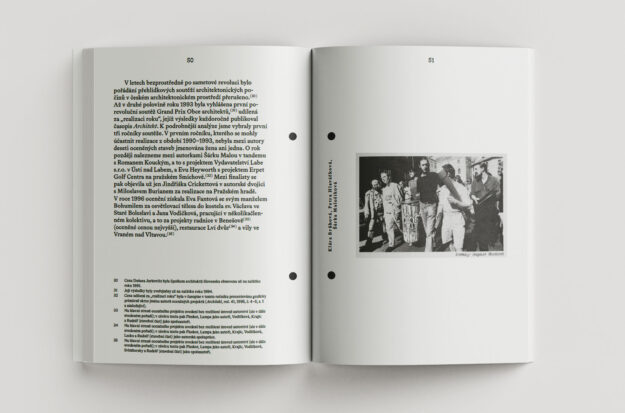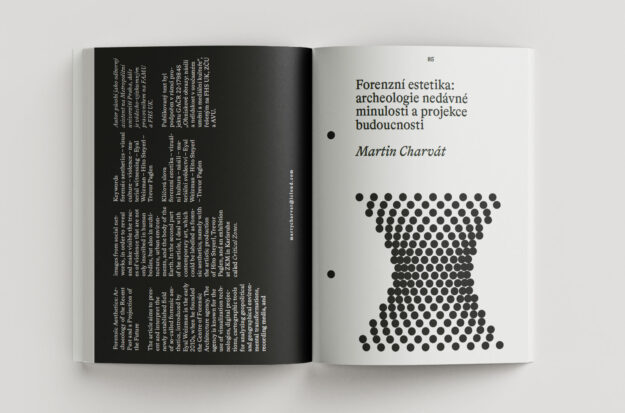The thirty-third issue of Notebook contains three original studies and one review. The first two texts deal with the period of so-called real socialism and the subsequent transition to a democratic regime in the first half of the 1990s. Martin Blažíček’s article Radek Pilař – dvojí český videoart (Radek Pilař – Double Czech Video Art) explores the differing positions in official and unofficial art, the relevant institutions and the technological and creative restrictions, taking the well known Czech artist as an example. Blažíček views Pilař as an artist who, thanks to the reputation he swiftly acquired as an children’s illustrator, was able to negotiate agilely with the state authorities, though his attempts at creative emancipation did not always enjoy success. Where are the Women Architects? is an essay by Klára Brůhová, Petra Hlaváčková and Šárka Malošíková looking at the media representation of architecture from a gender perspective. It analyses specialist architectural journals published in this country in the 1980s and 1990s, focusing on the representation of women and the subsequent creation of the image of a “successful (fe)male architect”. The last essay, by Martin Charvát and entitled Forensic Aesthetics: An Archaeology of the Recent Past and Projects of the Future, examines a sphere that is not yet well known in the Czech Republic: the use of visualisation technology, digital projection and cartographic tools to reveal traces of violence not only in human bodies but in architecture or the body of Planet Earth. The study operates in tandem with Martin Vrba’s review of the book Mengele’s Skull by Thomas Keenan and Eyal Weizman, a foundational text in the sphere of forensic aesthetics.
Content
Martin Blažíček
Radek Pilař – Two Kinds of Czech Videoart
This study, using the example of Radek Pilař, summarizes a specific type of video artists’ involvement at the time of the Czechoslovak political “normalization” of the 1980s. It focuses on the difference between positions of artists within official and unofficial art, related institutions, technological and creative limitations. From this perspective, using the example of the video industry, the SČVU [Union of Czech Visual Artists], and the production unit Supraphon Music Video, the author describes negotiating strategies in the promotion of video art as a creative discipline within state cultural organizations. The study discusses Radek Pilař as an artist introducing current themes of contemporary art into the beginning of normalization, but soon successfully establishing himself in the field of art for children. Thanks to his quickly acquired reputation in this area, he became an ambivalent actor who could negotiate effectively with state authorities, but at the same time did not always fulfill his own creative emancipation.
Klára Brůhová, Petra Hlaváčková, Šárka Malošíková
Where Are the Women Architects? Professional Journals and the Shaping of Gender Aspects of Architectural Discourse
The study focuses on the topic of architecture media representation from a gender perspective. It brings a discursive analysis of professional architectural magazines published in the Czech environment in the 1980s and 1990s, namely Architektura ČSR, Československý architekt and Architekt. The aim is to provide a reflection on the principles of the formation of architectural discourse from the perspective of feminist criticism. The main parameter of our analysis is to evaluate the representation of women architects. We look at how women in architecture are written about, what qualities and characteristics are emphasised, and which of their works are published. We put the findings in the context of the formation of the image of the „successful architect“ and try to trace whether and how this image is gendered or stereotyped. We also focus on whether in this regard there had been any changes in the researched period.
Martin Charvát
Forensic Aesthetics: Archaeology of the Recent Past and a Projection of the Future
The article aims to present and interpret the newly established field of so-called forensic aesthetics, introduced by Eyal Weizman in the early 2010s, when he founded the Centre of Forensic Architecture agency. The agency is known for the use of visualization technologies, digital projections, cartographic tools for analyzing geopolitical and geographical environmental transformations, recording media, and images from social networks, in order to reveal and make visible the traces of violence that are not only inscribed in human bodies, but also in architecture, urban environments, and the body of the Earth. In the second part of the article, I deal with contemporary art, which could be labelled as forensic aesthetics, namely with the artistic production of Hito Steyerl, Trevor Paglen, and an exhibition at ZKM in Karlsruhe called Critical Zones.
Martin Vrba
Forensic Aesthetics in the Post-Factual Age
Review of the book Mengele’s Skull by Thomas Keenan and Eyal Weizman, Prague: AMU Publishing House, 2022, 116 s



